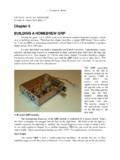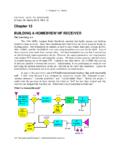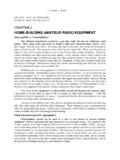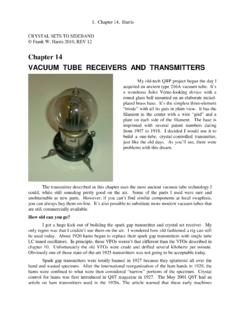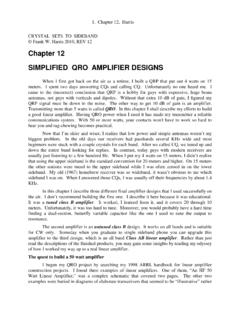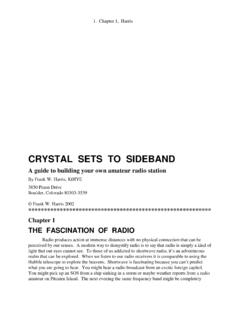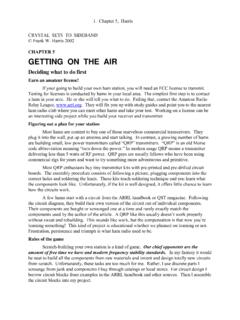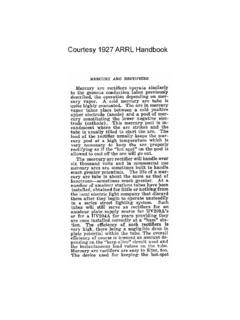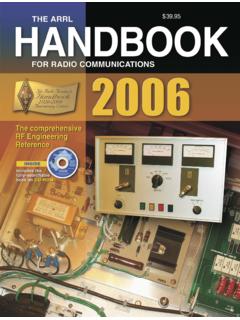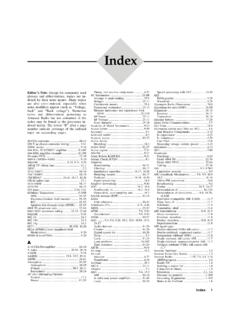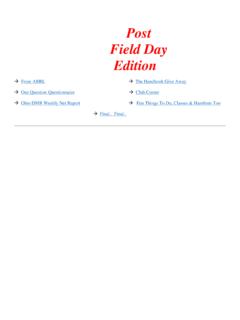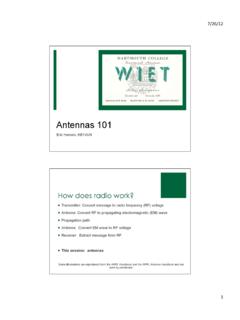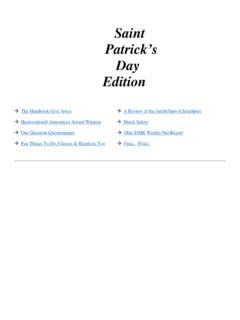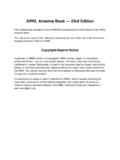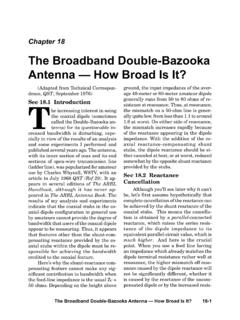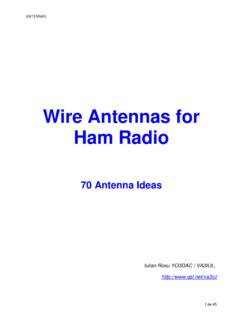Transcription of Variable Frequency Oscillators (VFOs)
1 1. Chapter 10, Harris CRYSTAL SETS TO SIDEBAND. Frank W. Harris 2010, REV 12. Chapter 10. Variable Frequency Oscillators ( vfos ). Sooner or later you'll become frustrated with being stuck on a few crystal-controlled frequencies. You would like to have a Frequency -tuning knob that covers the entire band and not just a few kilohertz. This sounds simple, but isn't. It's difficult because, without the stability of a crystal, an ordinary RF oscillator will drift hundreds of hertz while you're sending. The fellow you're talking to probably has a modern transceiver with a narrow, stable passband. From his perspective your signal quickly drifts out of his passband. His digital readout may be calibrated to tenths of a Hertz and he will take great delight in telling you about YOUR PROBLEM. Drift is a big deal today In the old days, like 1950, receiver passbands were usually huge, like 10 or 20 kilohertz. So you could drift quite a distance before your contact even noticed, let alone could no longer hear you.
2 Besides, everyone drifted a little back then, so it wasn't worth mentioning. In the really old days, like 1930, the signals drifted so much, that hams often tuned their receivers with one hand while they copied down the Morse code with the other. A stable Variable Frequency oscillator can replace a crystal oscillator. This chapter summarizes what I learned in my odyssey through six VFO prototypes. My early vfos drifted hundreds of Hz and I got loads of complaints. After I added temperature compensation, I got the instability down to 20 Hz drift per minute. Some stations notice 20 Hz drift and a few even told me about it. Eventually I built a super-regulated power supply for the VFO. and got the drift down to about 5 Hz. I. suggest you avoid embarrassment and work directly toward 5 Hz. According to the arrl handbook , +/- 5 Hz is about as stable as you can achieve without phase lock loop technology. A 5 MHz VFO tuned by a mechanical Variable capacitor 2. Chapter 10, Harris I was recently talking to a brand new local ham on 40 meters CW.
3 We were chatting at a leisurely 5 words per minute. He, of course, was using a wondrous modern transceiver. It took us an hour to communicate very little information. Finally he tired of the strain and called me on the phone. "By the way," he said, "were you aware that you drifted over 50 Hz during our QSO?" He thought he was informing me of a grievous defect in my rig. Less than 1 Hz per minute? I was delighted that the drift was so low. The test equipment needed to build a VFO are a precision multimeter for measuring voltage down to millivolts and a Frequency standard. A super-accurate, modern receiver is OK, but a Frequency counter is better for this application. The hardest part about building a stable VFO is following all the detailed instructions on how to do it. If you're like me, you'll have trouble believing that all that trivia is really necessary. Yes, you can cut a few corners, but the more compromises you make, the more your VFO will drift. Low Frequency vfos drift less than high Frequency vfos It's practical to build a VFO that operates directly on 160 meters ( to MHz) or on 80 meters ( to MHz).
4 This makes transmitter design simple. For these bands you just amplify the VFO signal directly. For example, if you had a crystal-controlled QRP designed for 80 meters, an 80 meter VFO could be plugged directly into the crystal socket. You might want to attenuate the signal somewhat before directly substituting a crystal, but the VFO can replace the crystal and allow you to tune all over the band. If you can build a really first rate VFO for 40. meters, that band would also be practical. Unfortunately, for a given level of sophistication and precision, Frequency drift is directly proportional to Frequency . You will probably find that somewhere above 5 MHz, there is too much instability to keep the drift under 5 Hz per minute. In order to build a low drift VFO for 40 meters or above, a low Frequency VFO can be "converted" up to the desired high Frequency . Conversion means adding the VFO to a high Frequency crystal oscillator signal and then extracting the sum Frequency with a filter.
5 Frequency conversion is covered in chapter 11. Considering the size of most HF ham bands, a VFO needs a tuning range of at least MHz. The higher the basic Frequency of the VFO, the wider the tuning range you can achieve. arrl handbook VFO projects have various frequencies ranging from to 9 MHz. My CW. transmitter VFO ranges from to MHz. My receiver and SSB-transmitter vfos tune from to MHz. In retrospect, if I were starting over, I would have built the 5 MHz VFO first, since that Frequency turns out to be more versatile. The disadvantage of a 5 MHz VFO is that it can't be used on any hamband directly and every hamband needs a Frequency converter circuit. (Yes, a 5 MHz VFO can reach 60 meters. But CW isn't permitted on 60 and generating SSB on the same Frequency on which you're transmitting requires a phase shift technique that is rarely used today.). JFET transistors Junction Field Effect Transistors (JFETs) are ideal for building vfos . Unlike bipolar transistors, the main current from the drain to the source does not pass through any PN junctions.
6 PN junctions change their characteristics with temperature. Therefore, vfos made from bipolar transistors tend to drift more than JFETs. JFETs work on the same principle as a MOSFET, but the control gate is a P-N junction diode rather than a capacitor. JFETs were explained and used in the VFO oscillator in the direct conversion receiver in chapter 7. 3. Chapter 10, Harris THE VFO CIRCUIT. The basic oscillator In principle the VFO is almost the same as a quartz crystal oscillator. The crystal is electrically equivalent to an LC resonant circuit. Therefore, to tune a VFO we use either a Variable capacitor or a Variable inductor to change the resonant Frequency . So far as I know, suitable Variable inductors can't be bought or built in a home workshop. That means that the tuning element will have to be a Variable capacitor, much like the one you used to adjust the crystal Frequency in your QRP. The circuit above is essentially what you will find in your arrl handbook .
7 It uses a JFET transistor. The oscillator is a Colpitts and can be recognized by the capacitive divider feedback, C3 and C4. Whenever the source voltage goes up, some of this change is coupled to the gate through C3. This turns the JFET more ON. That is, the feedback is positive which sustains the oscillation. The basic LC resonant circuit that determines the Frequency is C1 and L1. C2 is a trimmer capacitor to help adjust the desired tuning range. So what are the values of C1, L1, C2, The answer isn't simple. We start with a quality Variable capacitor for C1 as described below. For various reasons, C1 will probably be about 30 pF. Starting with this capacitor and the need for a MHz tuning range, the other values must be determined by trial and error. The values are extremely hard to calculate because C3, C4 and even the 1N914 diode are part of the capacitance. Don't try too hard to get the values right until you have studied this entire chapter and formulated a plan for your VFO.
8 As you will see later, C2, C3, and C4 are part of the temperature compensation strategy and will need to be determined by those considerations first. When you have decided what to do about C3 and C4, then you can work on L1 and C2. The 470 Henry choke in the source circuit serves as the load resistor. That is, the oscillator sinewave output is locked in between the operating voltage, +5 volts, and ground. Since the sinewave voltage appears across the transistor, the remainder, 5 volts minus the sinewave, must appear across a load of some sort. This choke could be functionally replaced with a resistor, except that a resistor dissipates energy and gets hot. The last thing you need in your VFO is another source of heat. The choke inductance is high enough so that the current through it changes very little during one RF cycle and its effect on the Frequency of oscillation is 4. Chapter 10, Harris minimal and unchanging. While we're on the subject, you might experiment with substituting an volt precision Zener diode for the 5 volt diode.
9 This would of course cut the amplitude of the oscillation in half, but it will also decrease the circuit heating to one fourth. It may not work out for you, but anything that reduces heating, increases stability. The 1N914 diode on the gate seems counter-productive, but it is used as a clamp to keep the base of the JFET transistor out of the forward conduction region. That is, when the oscillation gets too vigorous and the gate P-N junction begins to turn on at volts, the diode will help prevent operation in this range. The VFO as a whole is powered by 12 volts. However, 5 volts derived from a Zener diode regulator (Z) power the oscillator stage and its buffer. This is done to dissipate as little energy as possible in the oscillator and prevent the components from heating. The entire VFO circuit Here is the entire VFO circuit, excluding the temperature compensation. As you can see, the VFO also contains a buffer stage and a final amplifier. Temperature compensation consists of special circuits that replace either C2 or C4.
10 Buffer The buffer stage separates the oscillator from the final amplifier. Otherwise there would be a subtle connection between the load on the VFO output and the oscillator. Believe it or not, without the buffer, if you change the load on the VFO output slightly, the Frequency will change too. The buffer is connected to the other stages by C5 and C6. These capacitors should be as small as possible to reduce the connection between the oscillator and final amplifier. 5. Chapter 10, Harris Final amplifier The final amplifier raises the VFO output up to the level needed to drive the transmitter. The stage being driven in the transmitter is usually a mixer which we shall discuss in the next chapter. But, if the VFO is designed for the 80 meter ham band, then the next stage after the VFO could be a string of class C amplifiers to increase the output power to the final level, say 5. or 50 watts. The VFO final stage will need to deliver at least two volts peak sine wave.
